The NVIDIA GeForce GTX 980 Ti Review
by Ryan Smith on May 31, 2015 6:00 PM ESTPower, Temperature, & Noise
As always, last but not least is our look at power, temperature, and noise. Next to price and performance of course, these are some of the most important aspects of a GPU, due in large part to the impact of noise. All things considered, a loud card is undesirable unless there’s a sufficiently good reason – or sufficiently good performance – to ignore the noise.
As the GM200 flagship card, GTX Titan X gets the pick of the litter as far as GM200 GPUs go. GTX Titan X needed fully-functional GM200 GPUs, and even then needed GPUs that were good enough to meet NVIDIA’s power requirements. GTX 980 Ti on the other hand, as a cut-down/salvage card, gets second pick. So we expect to see these chips be just a bit worse; to have either functional units that came out of the fab damaged, or have functional units that have been turned off due to power reasons.
| GeForce GTX Titan X/980 Voltages | ||||
| GTX Titan X Boost Voltage | GTX 980 Ti Boost Voltage | GTX 980 Boost Voltage | ||
| 1.162v | 1.187v | 1.225v | ||
Looking at voltages, we can see just that in our samples. GTX 980 Ti has a slightly higher boost voltage – 1.187v – than our GTX Titan X. NVIDIA sometimes bins their second-tier cards for lower voltage, but this isn’t something we’re seeing here. Nor is there necessarily a need to bin in such a manner since the 250W TDP is unchanged from GTX Titan X.
| GeForce GTX 980 Ti Average Clockspeeds | |||
| Game | GTX 980 Ti | GTX Titan X | |
| Max Boost Clock | 1202MHz | 1215MHz | |
| Battlefield 4 |
1139MHz
|
1088MHz
|
|
| Crysis 3 |
1177MHz
|
1113MHz
|
|
| Mordor |
1151MHz
|
1126MHz
|
|
| Civilization: BE |
1101MHz
|
1088MHz
|
|
| Dragon Age |
1189MHz
|
1189MHz
|
|
| Talos Principle |
1177MHz
|
1126MHz
|
|
| Far Cry 4 |
1139MHz
|
1101MHz
|
|
| Total War: Attila |
1139MHz
|
1088MHz
|
|
| GRID Autosport |
1164MHz
|
1151MHz
|
|
| Grand Theft Auto V |
1189MHz
|
1189MHz
|
|
The far more interesting story here is GTX 980 Ti’s clockspeeds. As we have pointed out time and time again, GTX 980 Ti’s gaming performance trails GTX Titan X by just a few percent, this despite the fact that GTX 980 Ti is down by 2 SMMs and is clocked identically. On paper there is a 9% performance difference that in the real world we’re not seeing. So what’s going on?
The answer to that is that what GTX 980 Ti lacks in SMMs it’s making up in clockspeeds. The card’s average clockspeeds are frequently two or more bins ahead of GTX Titan X, topping out at a 64MHz advantage under Crysis 3. All of this comes despite the fact that GTX 980 Ti has a lower maximum boost clock than GTX Titan X, topping out one bin lower at 1202MHz to GTX Titan X’s 1215MHz.
Ultimately the higher clockspeeds are a result of the increased power and thermal headroom the GTX 980 Ti picks up from halving the number of VRAM chips along with disabling two SMMs. With those components no longer consuming power or generating heat, and yet the TDP staying at 250W, GTX 980 Ti can spend its power savings to boost just a bit higher. This in turn compresses the performance gap between the two cards (despite what the specs say), which coupled with the fact that performance doesn't scale lineraly with SMM count or clockspeed (you rarely lose the full theoretical performance amount when shedding frequency or functional units) leads to the GTX 980 Ti trailing the GTX Titan X by an average of just 3%.
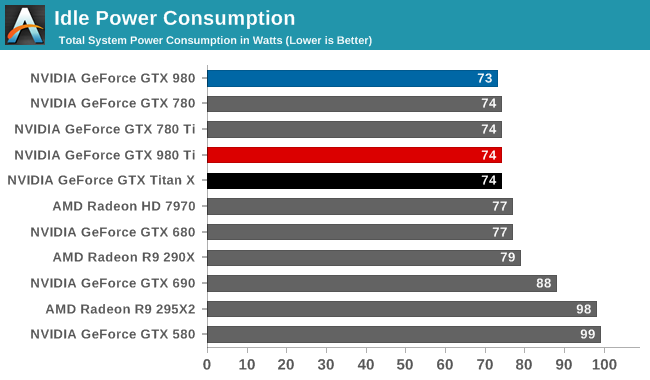
Starting off with idle power consumption, there's nothing new to report here. GTX 980 Ti performs just like the GTX Titan X, which at 74W is second only to the GTX 980 by a single watt.
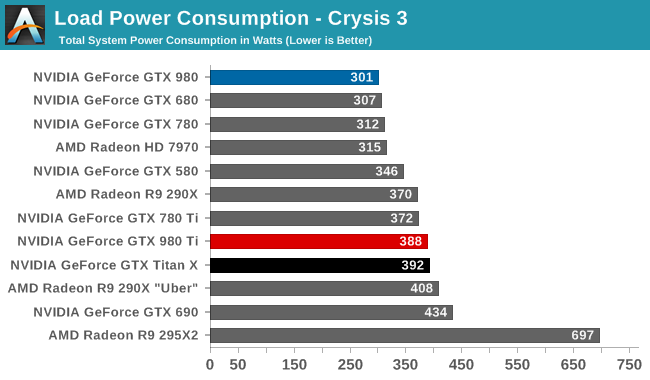
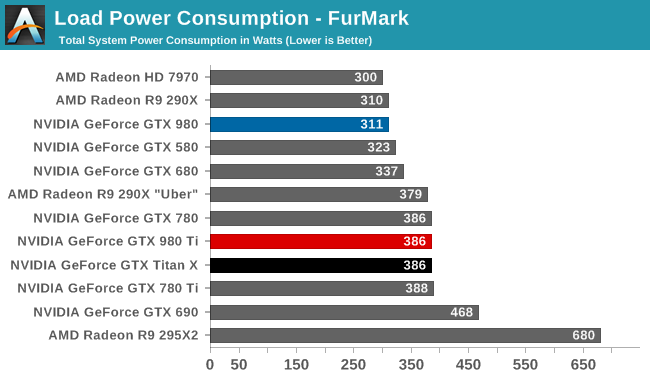
Meanwhile load power consumption is also practically identical to the GTX Titan X. With the same GPU on the same board operating at the same TDP, GTX 980 Ti ends up right where we expect it, next to GTX Titan X. GTX Titan X did very well as far as energy efficiency is concerned – setting a new bar for 250W cards – and GTX 980 Ti in turn does just as well.
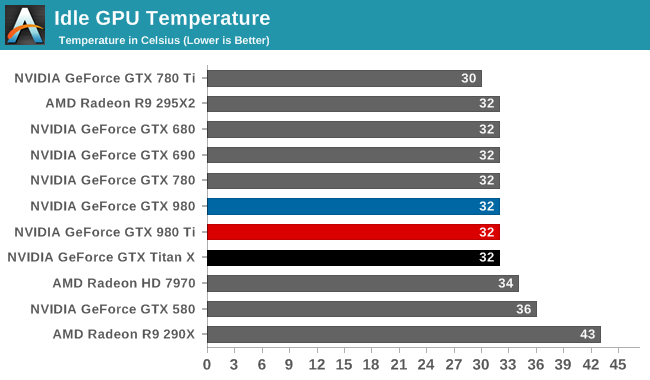
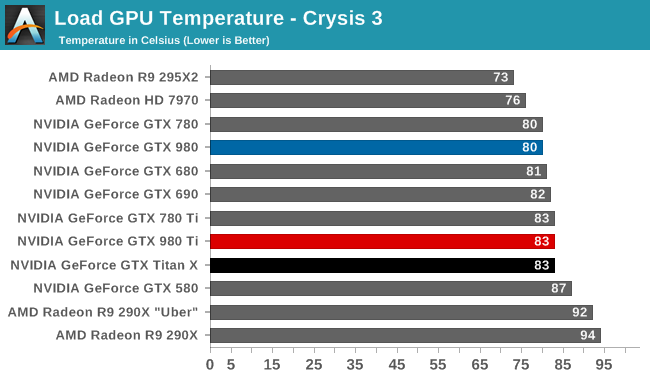
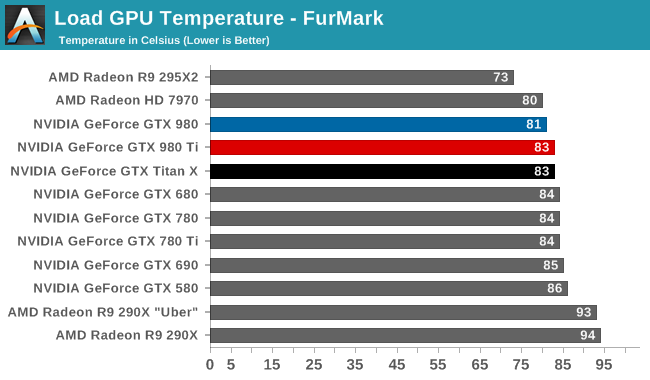
As was the case with power consumption, video card temperatures are similarly unchanged. NVIDIA’s metal cooler does a great job here, keeping temperatures low at idle while NVIDIA’s GPU Boost mechanism keeps temperatures from exceeding 83C under full load.
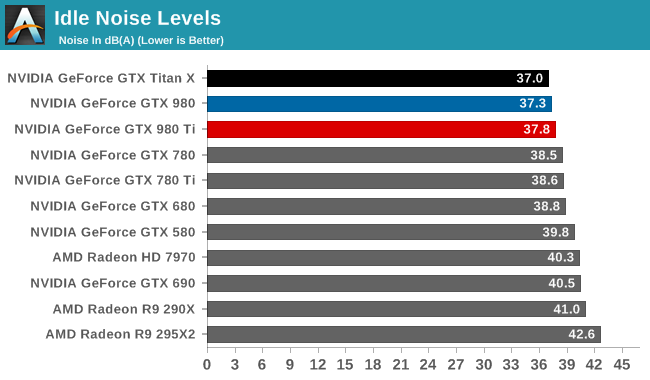
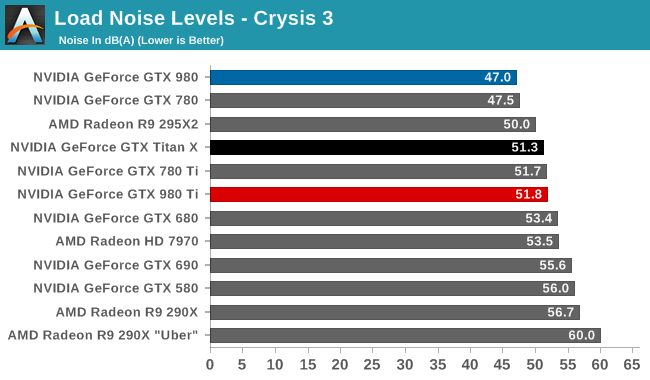
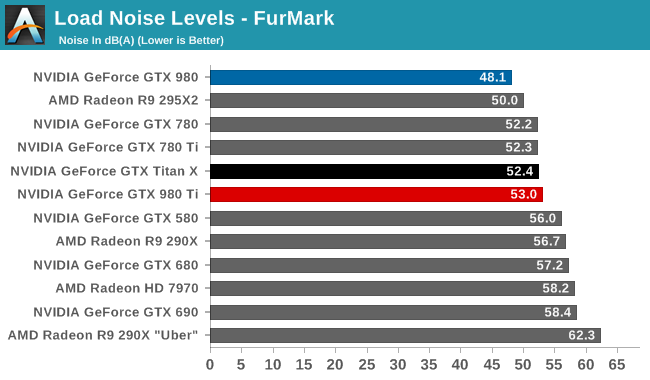
Finally for noise, the situation is much the same. Unexpected but not all that surprising, the GTX 980 Ti ends up doing a hair worse than the GTX Titan X here. NVIDIA has not changed the fan curves or TDP, so this ultimately comes down to manufacturing variability in NVIDIA’s metal cooler, with our GTX 980 Ti faring ever so slightly worse than the Titan. Which is to say that it's still right at the sweet spot for noise versus power consumption, dissipating 250W at no more than 53dB, and once again proving the mettle of NVIDIA's metal cooler.










290 Comments
View All Comments
FlushedBubblyJock - Wednesday, June 10, 2015 - link
Thumbs up daroller, 1920x1200 and only 980TI is capable of driving it properly without eye candy loss and fps failures.People claim I'm crazy but then I never have to worry about my settings and I can seamlessly choose and change and view and analyze and I'm never frustrated "having to turn down the settings" to make things playable.
The rest of the world stretches livability to the limit and loves stressing everything to the max an grinding it all down to pathetic perf, all the while claiming "it's awesome !"
In other words, stupidity is absolutely rampant.
Yojimbo - Monday, June 1, 2015 - link
Value is not performance per price. Value is what benefit is achieved by the purchase of the product. I'll repeat my previous post by asking how can you assume that purchasing a card has "unreasonable value"? If I, as someone who is in the market for a video card, have a range of options to choose from for myself, how can you off-the-cuff judge how much I should be willing to spend to get a better experience (higher resolution, more detailed graphics, smoother game play, etc) from a higher-priced offering compared with a lower-priced offering? You have no idea what my value of those experiences are, so how can you judge whether the cards offer good value or not?The people buying those high priced cards are buying them because in their minds they are getting more value from them at the higher price than they would be getting from the lower-priced alternatives. Now people don't always make the most accurate decisions. They can be fooled, or they can have misconceived notions of what they are going to be getting, but the point is that they THINK they are getting more value at the time of purchase.
mapesdhs - Wednesday, June 3, 2015 - link
Or they can simply afford it and want the *best* for other reasons such as being able to max out visuals without ever worrying about VRAM issues. It's wrong to assume such purchases are down to incorrect value judgements. You're imposing your own value perception on someone else.chizow - Sunday, May 31, 2015 - link
Yeah, unfortunately anyone who actually buys high-end GPUs understands price and performance goes out the window the higher you go up the product chain. Nvidia made their value play to the masses with the 970 at an amazing $330 price point, memory snafu notwithstanding, and the card has sold incredibly well.There was no reason for them to drop prices further, and I think most observers will recognize the $650 price point of the 980Ti is actually very aggressive, given there was absolutely no pressure from AMD to price it that low.
Kjella - Sunday, May 31, 2015 - link
If AMD gets to launch first and nVidia must respond, it seems like they're trading blows. If nVidia makes a preemptive strike now, they make AMD's launch seem late and weak. They know AMD is betting on Win10 driving sales, so they could read their launch plan like an open book and torpedo it out of the gate. I think this will be a miserable month for AMD, it's hard to see how GCN-based cards are going to compete with Maxwell, HBM or not.chizow - Sunday, May 31, 2015 - link
Yep, Nvidia just pre-emptively torpedoed AMD's product launch and set pricing again. All very impressive how Nvidia has gone about 28nm product launches despite the uncertainty we'd see anything new until 14/16nm after word 20nm was cancelled.PEJUman - Monday, June 1, 2015 - link
I don't think Nvidia is dumb enough to launch 980TI without knowing where FIJI would lay on their stack. I think this is more of a powerplay from them saying, 'here's your price point AMD, good luck'like you said, the fact is they have no competitive pressure on titan X, why ruin it's pricing now if you don't know where FIJI would land.
here's my guess:
Nvidia just torpedoed their titan X, mainly because FIJI probably around 97% of titan X, and AMD was about to ask 850~1000 USD for it. now Nvidia will launch this 980TI at 650 to control the price. (which I bet they have been readying for quite some time, simply waiting for the right time/price point)
Peichen - Monday, June 1, 2015 - link
I think you are right. Fuji was estimated to be close to Titan but cheaper by $200. Now Nvidia delivered a Fuji-like card for $650, Fuji cannot go above $650. In fact, consider Fuji to be limited to 4GB and hot enough to have a watercooled version, Fuji might have to go below $600 with bundle game or $550 without bundle to make any sense. With the big chip and expensive memory Fuji is using, AMD/ATI's margin on those card are going to be slim compares with Nvidia.PEJUman - Monday, June 1, 2015 - link
yeah... time to buy AMD stock options :)In all honestly though, I really would like to have them around, if only for the 2 horses race...
bloodypulp - Monday, June 1, 2015 - link
For christsake... it's Fiji. NOT Fuji.